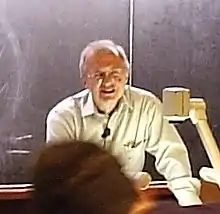Friedlander–Iwaniec theorem
In analytic number theory the Friedlander–Iwaniec theorem states that there are infinitely many prime numbers of the form . The first few such primes are
- 2, 5, 17, 37, 41, 97, 101, 137, 181, 197, 241, 257, 277, 281, 337, 401, 457, 577, 617, 641, 661, 677, 757, 769, 821, 857, 881, 977, … (sequence A028916 in the OEIS).

John Friedlander

Henryk Iwaniec
The difficulty in this statement lies in the very sparse nature of this sequence: the number of integers of the form less than is roughly of the order .
History
The theorem was proved in 1997 by John Friedlander and Henryk Iwaniec.[1] Iwaniec was awarded the 2001 Ostrowski Prize in part for his contributions to this work.[2]
Special case
When b = 1, the Friedlander–Iwaniec primes have the form , forming the set
- 2, 5, 17, 37, 101, 197, 257, 401, 577, 677, 1297, 1601, 2917, 3137, 4357, 5477, 7057, 8101, 8837, 12101, 13457, 14401, 15377, … (sequence A002496 in the OEIS).
It is conjectured (one of Landau's problems) that this set is infinite. However, this is not implied by the Friedlander–Iwaniec theorem.
References
- Friedlander, John; Iwaniec, Henryk (1997), "Using a parity-sensitive sieve to count prime values of a polynomial", PNAS, 94 (4): 1054–1058, doi:10.1073/pnas.94.4.1054, PMC 19742, PMID 11038598.
- "Iwaniec, Sarnak, and Taylor Receive Ostrowski Prize"
Further reading
- Cipra, Barry Arthur (1998), "Sieving Prime Numbers From Thin Ore", Science, 279 (5347): 31, doi:10.1126/science.279.5347.31.
This article is issued from Wikipedia. The text is licensed under Creative Commons - Attribution - Sharealike. Additional terms may apply for the media files.